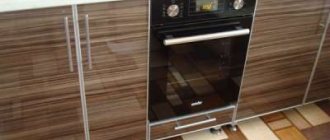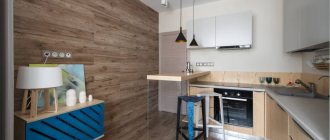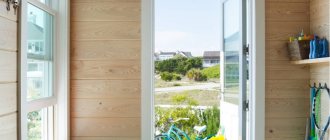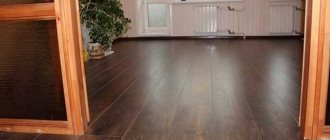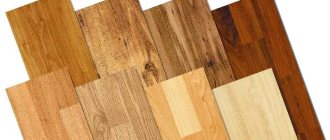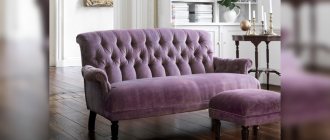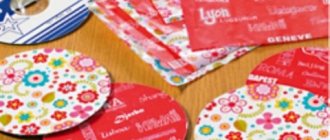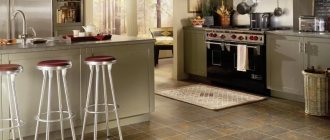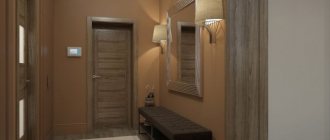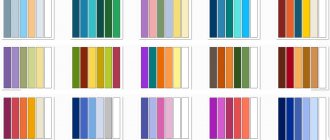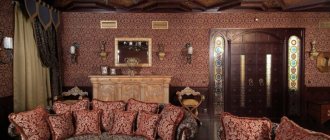What is it for?
If you use a substrate, then in different situations an additional layer:
- Acts as a shock absorber of dynamic pressures. When the rough base cannot boast of a perfectly flat surface without small flaws, insulating material must be placed to hide them.
- Compensates for minor imperfections in the subfloor with minor differences of up to 2 mm/m2, preventing premature wear of the surface covering due to additional loads created by surface tension due to bends and fractures.
- It insulates moisture, which is important for apartments located on the first floors. The cause of cold floors is the unheated damp basement below.
- Absorbs sounds and helps retain heat. The comfort of using linoleum is largely influenced by the noiselessness of the floor covering in combination with its heat-insulating ability.
The disadvantage of using the underlay is that it creates a certain softness of the floor. Despite the fact that for some people moving on such a floor is comfortable, while others are against it, installing heavy furniture on a soft floor covering is always fraught with negative consequences. Bulky storage systems can stand up unevenly, which will cause the structures to warp, and pieces of furniture with legs under pressure will deform the linoleum, leaving strong dents.
When laying linoleum, you should avoid using extruded polystyrene foam. This material in the form of panels with a thickness of 10 to 20 mm is ideal as a substrate for laminate flooring. But not for such a soft surface as linoleum. If you put panels under it, the floors will turn out to be unsteady, providing an unpleasant sensation when walking. The use of MDF panels eliminates this problem.
Since most often the preparation of a wooden base, as well as a concrete screed, involves the use of cut-off waterproofing. So, taking into account the pros and cons of the substrate, the need for its use is always determined by specific circumstances.
Laminate or linoleum - which is better: the opinion of an expert builder
Examples of beautiful baths: 30 photos of interesting style and architectural solutions
Laying the flooring begins with... its delivery. Transportation is an important point, and here laminate is much more convenient. It is sold packaged in small and fairly light packs, which are easy to put into the trunk yourself, without the help of others, and then lift into the apartment.
Dark brown laminate in a light kitchen
To deliver linoleum, you will need an assistant, especially if we are talking about a large area - it is almost impossible to transport a heavy pipe about 4 m high alone. In addition, such a tall package will not fit in any elevator, so you will have to lift it up the stairs. So you will have to order delivery and, possibly, the services of loaders.
Dark red linoleum in the kitchen
To lay linoleum, the subfloor will require more thorough preparation, while laminate can be laid without filling small depressions and defects - it will simply hide them and the resulting coating will be perfectly smooth. Linoleum not only does not hide minor defects, but it may well tear over a depression (pothole).
Laminate flooring in various wood shades in the kitchen
Linoleum with black and white pattern in the bathroom
Under both coatings you will need to lay a substrate - for a laminate this is a prerequisite, for linoleum it depends on its thickness (or when foamed polystyrene or a fiber layer is applied to its back side). This will improve the heat and sound insulation of the resulting coating.
Light laminate in a beige bedroom
Blue-blue linoleum with a square pattern in the kitchen
Laying linoleum, especially if the room is small in area, will take much less time - in this case, you can get by with a solid coating and do the work yourself. In a large room, after installation, you will have to weld the seams - it is better to entrust this work to a professional, otherwise over time the seam may begin to separate, and the linoleum itself may first lag behind the floor, and over time, wrap up.
Hot pink linoleum in the kitchen
White and yellow striped linoleum in a children's room
Linoleum is laid on adhesive double-sided tape or glue, plus it is additionally pressed (fixed) to the wall with a plinth. These are additional costs to consider. If laid incorrectly, air voids may form under the linoleum, but it is almost impossible to re-lay the covering.
Linoleum with a green pattern on a white background in the bathroom
Laying laminate flooring will require more time - you will have to cut, adjust and connect the laminated boards, joining them individually and in a row. But in general, this is a fairly simple process that simply requires strict adherence to step-by-step instructions. The laminate is not attached to the substrate (floating floor), so there is always the opportunity to disassemble it and rearrange it if something goes wrong.
Light laminate flooring in a room with large windows
Dark laminate goes well with the color scheme of the interior
The light shade of the laminate helps to visually increase the space of the kitchen
Where can I lay a product on abandoned linoleum?
Ideal conditions for using linoleum and laminate flooring are found in living rooms. You can also use a combination of these coatings in the hallway, dressing room, pantry. In these rooms, the life of the floor will be long, and the coating will be perfectly smooth.
Laminate flooring in the living room will last a long time
The situation is completely different when there is a high level of moisture in the air. Therefore, a bathroom, poorly insulated balcony or kitchen is not the best option. In addition to high moisture, constant temperature changes will also damage materials.
When laying laminate flooring in such rooms, you need to be prepared for future swelling and other types of deformation. And the appearance of the lamellas will deteriorate. In the bathroom and kitchen you can use special insulating substrates, but it is better not to experiment, but to use tiles.
Kinds
Which is better than laminate or linoleum in an apartment on the ground floor in terms of harmfulness?
The name linoleum imitating laminate implies a type of linoleum that visually imitates a laminate coating. The classification of linoleum coverings, including those imitating laminate, is based on the material, design features and intended purpose.
Classification according to materials of manufacture:
- Natural;
- PVC;
- Rubber;
- Nitrocellulose.
Classification by level of durability and wear:
Domestic. These are coverings ~4 mm thick, made of synthetic PVC on a foam and fabric base. This linoleum is soft and has good heat and sound insulation properties.
This covering option is used in children's rooms, bedrooms and offices; it is practical and inexpensive, quite aesthetic and is used “under laminate”.
- Semi-commercial. Unlike the first, household type, the semi-commercial one has a thicker layer of protection, durability and a higher wear resistance class (31-32). As a rule, it is used for flooring in hallways, corridors, living rooms, kitchens, as well as business premises with limited traffic. It reliably recreates laminated panels, looks respectable and includes many of the qualities of household and commercial linoleum.
- Commercial. Made from polyvinyl chloride. Often this is a single-layer type of 33-34 wear resistance class, used without additional backing. Often used for flooring in shopping malls and areas with high traffic, educational institutions and large office premises. It has a thick protective layer (0.5 mm) and wear resistance class 33-34, is durable, can last up to 25 years, and shows a high level of resistance to fracture, friction, and vertical pressure. In its production, many special additives are used that increase quality indicators and positive characteristics. Such linoleum, as a rule, has a high cost.
Classification by structure:
- Homogeneous or single-layer, made from a mixture of polyvinyl chloride and dyes, has the highest quality characteristics in terms of wear resistance;
- Heterogeneous or multilayer, including five layers or more. The first is a base made of fabric or foamed PVC. The second one adds fiberglass to increase strength. The third layer plays a decorative role and also has a protective coating. Heterogeneous linoleum can be of both household and semi-commercial types.
Homogeneous options are usually sold in a limited assortment and in a single color variation (mainly light or dark tones). Although, there are also original new items.
Heterogeneous coatings have a wider range of colors and better imitate laminate, wood or tile coatings, which is why they are more popular on the market.
Linoleum can also be divided into two types based on the presence of a base. To lay coverings with a base made of polyvinyl chloride, jute or felt, no additional substrate is required.
Thanks to the modern production system, linoleum can be laid either in individual strips or in shaped fragments, depending on the type of room.
general information
How to make suspended ceilings in the hall with and without lighting, how to choose? review and ideas + design photos: pros and cons
To understand what to choose - laminate or linoleum - first, let's get a clear idea of what both materials are.
Laminate
The basis of the material is MDF or HDF. In essence, it is just pressed hardboard - fine wood dust in the form of short cellulose fibers and a binder - polymer resin.
A protective coating less than a millimeter thick is applied to the front side. The class of the laminate depends on its thickness and strength. The higher it is, the more wear-resistant this flooring will be. The back side is protected from getting wet by a thin layer of polymer.
All ends represent different elements of a click lock - a simple latch that securely fixes laminate boards, combining them into a single wide shield.
The click lock can be seen on both laminate and parquet boards.
Linoleum
And here we will leave out of our attention exotic things like expensive types of linoleum, made exclusively from natural materials.
Let's look at the most common types of this coating.
Homogeneous linoleum is, first of all, different types of commercial coatings made entirely of monolithic polyvinyl chloride with a plasticizer. The pattern is often not a coating, but a dye embedded throughout the entire thickness.
Hence, an almost unlimited service life in high traffic conditions. A side consequence is the absence of a complex pattern on such linoleum.
Heterogeneous linoleum is up to six layers of different materials in a single coating. Foamed polyvinyl chloride, fabric and non-woven fabric bases, felt and some other materials are used. The combination of different layers allows you to obtain a material with specified properties. Including improved heat and sound insulation.
One of the options for heterogeneous linoleum.
A property common to both types of flooring is that they can be used with an underlay. Actually, the substrate for the laminate and its installation is a mandatory operation; for linoleum - optional.
As always, there is a nuance. The rigidity of the laminate distributes the load when walking over a larger area, making it less springy on a thick, soft substrate. But deformation is much more dangerous for him. First of all, click locks suffer.
On the other hand, linoleum can withstand repeated bending more easily. But the floor on a thick substrate will sag very much, and in the case of heavy furniture, the linoleum may be damaged.
Now we have a starting point for making a reasoned decision about what is better - linoleum or laminate - for each of the parameters important to the consumer, you can even choose linoleum for laminate.
How to correctly combine colors in the interior?
How to repair linoleum with various damages
Light linoleum visually enlarges the room. To create harmony and comfort in a room, you need to know a few simple but very important rules for combining different shades. Knowing these features, you will be able to visually expand the limits of compact spaces, making them brighter and more comfortable:
- The effect of increasing space. White linoleum in combination with light walls and ceiling will significantly expand the boundaries of the room, making it more spacious;
- The effect of lengthening the room. To make the room longer, it is advisable to choose light, modern linoleum and paint the back wall of the room in any shade of beige. In this case, it is advisable to make the walls and ceiling dark;
- The effect of reducing the depth of space. Suitable for “leveling” recessed rectangular rooms. All surfaces in the room are made light, except for the back wall, which should be painted in a darker color;
- The effect of reducing the height of a room. It is quite difficult to create a cozy atmosphere in rooms with high ceilings. But if you paint the walls beige, and the ceiling and floor brown or dark gray, the room will become much more comfortable.
Appearance in the interior
In the store, customers often ask consultants a question: what is the best finishing material to choose, light or dark?! Never make this mistake, because an employee of a retail outlet does not know your taste and character, personal color preferences, and has not seen your house or apartment. The seller’s task is to select the best one for the parameters of the room, its purpose without taking into account the decorative component. In addition, it is a long-known fact that linoleum on a monitor screen or in a sales area is significantly different in shade from the coating laid indoors. Its tone is affected by the intensity of the light flux, the color of the walls, furniture, etc.
In a room with a large glass area.
Figuratively speaking, elastic and modular laminate coatings are available in three color palettes, including:
- Natural wood shades - light and rich honey, amber, muted gray-blue and graphite tones like old or patinated wood;
- Coverings like bleached wood - as a rule, buyers use this term to refer to gray linoleum. In fact, this group includes no less than 40 halftones, from snow-white to blue-gray;
- Planks with imitation staining in dark tones - the whole range of brown, from light ocher to dark chocolate.
With the right approach, any color can bring comfort, tranquility and warmth to the interior. Or vice versa, give lightness and airiness to the room, set it in a working mood. The main thing is the right combination. Thus, all natural shades of ash, pine, oak, cherry or walnut are considered restrained, almost universal. This is an excellent solution for a home or office decorated in the style of timeless classics, inviting Scandinavian, elegant Empire or ambitious modern. If you plan furniture made of solid wood or wood, then the linoleum should be 1-3 shades lighter or darker.
With a furniture tint.
Walnut color.
In rooms with poor lighting or lack of sunlight, white linoleum or any shade of beige is recommended. But in order not to end up looking like a faceless hospital room, it needs to be balanced with dark accent inserts. A light floor will look fresh and elegant only in contrast with other furnishings. As a rule, bleached wood is popular when creating interiors in antique, English classicism, Renaissance, minimalism and others.
In a Scandinavian interior.
Looks like bleached wood.
The rich colors of tinted wood attract with beauty and solidity. Linoleum under laminate in wenge or stained oak looks heavy and visually overloads the room. Therefore, it must be diluted with light walls and furniture in warm colors. But without a doubt, such a coating will look very beautiful in any modern interiors or those decorated in antique, ethnic, etc.
In chocolate tones.
Anthracite.
Designers recommend choosing the right accent first. That is, the element that will serve as the starting color point. This could be a door, furniture, flooring. If possible, take samples of furniture or door facades to the store (not photos!) and try to select linoleum.
If you plan to create a kind of symbiosis interior, in which everything will complement each other, then the color scheme should be the same with a slight difference in halftones. Or you can try experimenting with texture. For example, lacquered furniture and matte linoleum with deep embossing and an aged wood pattern. Or a linoleum floor with an imitation of a radially cut laminate, and the furnishings resemble tangentially selected wood.
Contrast of textures.
Contrast of glossy furniture and matte linoleum.
There are many different cliches that regulate the combination of certain colors, materials, textures. But decoration is, first of all, creative. In the search for suitable finishing coatings, sometimes interesting compositions are discovered that do not fit into known rules. Therefore, if you like it, break traditions and feel free to create.
Good publicity
Most read
Disadvantages of using linoleum as a substrate
Experts believe that in order to obtain a higher quality and durable coating from laminated panels, it is better to dismantle the old linoleum and use a substrate specifically designed for this type of flooring.
Installation work
They justify their conclusions based on the following nuances.
Laminate flooring is essentially a floating structure, so it needs a strong and stable base. Linoleum cannot always be used in this capacity, since according to the installation technology there are no mandatory requirements for gluing it over the entire area.
Thus, using un-glued linoleum under laminate, you risk getting a lot of problems, from deformation of the floor to cracks in the panels themselves.
To correct the work done, you will have to disassemble the covering, remove the linoleum and re-make the flooring. As you understand, this will take a lot of money, time and moral strength.
If the lamellas are laid on an old coating, then after 8–10 years it will completely become unusable, and it will still need to be removed.
Over the years of use, a large amount of various types of debris accumulates under the linoleum, and the laminate covers it very tightly. Under the influence of moisture, the extent of which we cannot estimate, all this begins to rot. In any case, this process will lead to rotting of the lamellas, since their main part is made of fiberboard. Thus, the service life of the laminate will be reduced by 3 times.
Floor requirements
After selecting and purchasing a laminate, it should be allowed to rest for several days in the room in which it will be laid - this way the boards will become equal in humidity and temperature to the surrounding atmosphere. At this time, the remaining components for laying on linoleum are prepared - thresholds, baseboards, and underlay.
It is important to evaluate the existing coverage - it should be:
- whole;
- clean;
- dry;
- hard;
- smooth.
Hardness and evenness are the main requirements for the base. Various breaks, cracks or other differences in floor level are unacceptable. The slats should not be placed on a base that is too soft, as the boards will bend and sag, which will ultimately lead to cracks and broken locks.
Such options are definitely not suitable without restoration.
Do I need to remove linoleum?
Accordingly, if the linoleum meets all the requirements for integrity, hardness and evenness, you can leave it and lay lamellas on top.
There are three situations in which laminate flooring cannot be laid on linoleum - it is better to replace it:
- the coating has worn through to holes and cracks;
- the coating is swollen;
- the coating base was destroyed.
If the defects are small in area, then the floor can be restored:
- Cut out the deformed piece - cracks, holes, bulges.
- Carefully attach the cut point to the base of the floor.
- Fill the resulting holes with putty.
You can go another way:
- fill the swelling with glue using a syringe, press down and let it dry - the floor should become even;
- Carefully seal the cracks with silicone sealant.
But there is another important point - dryness.
In this case, there can be no two opinions - laminate should not be placed on wet linoleum.
The procedure is as follows:
- Not only linoleum is removed, but also all layers up to the cement screed.
- The cause of the increased humidity is being determined.
- The screed is cleaned and dried.
- The base is treated 2–3 times with antiseptic compounds.
- The floor is leveled if necessary.
- The substrate is laid, and then the lamellas.
Is leveling necessary?
For laying laminate, a height difference of no more than 3 mm per 1 square meter is allowed. m - such small inaccuracies are easily leveled out by the substrate. If the difference is higher, then there is a high risk that the base of the floor is bad, and it will have to be further corrected, and for this you will have to get rid of the linoleum.
In what cases can you do without leveling the base? Only in those if the floor is already perfectly flat. In the rest, it is better to repair, otherwise the slat locks will not hold up, they will break and creak.
How to check the evenness of the surface?
A difference of 2–3 mm per square meter is completely invisible to the eye, so the evenness of the floor must be double-checked. This can be done in several ways:
- Using a level rod or level one meter long. It is necessary to attach it to the floor in different places and see if there are differences. If yes, then measure them.
- Professionals use a laser level. It is expensive, so when installing it yourself there is no need to buy it.
- Pull the cord, along which you can clearly see the presence of bulges or depressions.
The difference in this floor is quite strong. It is advisable to level it with a self-leveling floor system and then lay the covering.
Examples and options
As you understand, laying laminate flooring on linoleum is a very real undertaking that you can do yourself. This process can be divided into several successive stages:
The first step is to prepare the surface. This step includes leveling the floor. Please note that if the linoleum lies on a surface with large differences, then this needs to be corrected. Therefore, the material is dismantled and the entire floor is filled with a self-leveling cement mixture. The next step is to fix the linoleum to the surface. For such purposes, special adhesives are used. The best option would be water-dispersion solutions, which are suitable for almost all types of surfaces
When choosing them, it is also important to take into account the structure of linoleum. Some mixtures can only bond PVC products, while others are used for thicker options with fabric or nap backing. The technology for fixing linoleum to the floor is quite simple and involves applying the mixture to the surface using a spatula and laying the canvas on it
To get rid of unevenness and air, you should level the linoleum using special rollers.
- The next step is to begin laying the laminate. It starts on one side of the room near the wall. The first row needs to be aligned with one of the planes, and also move 1-2 cm away from the wall. This will allow the material to expand with changes in temperature and humidity. The elements of the row are connected to each other using special grooves. If the length of one board is longer, then you need to trim it using a jigsaw.
- The next row is laid in a similar way. But at the same time, adjacent boards are already fastened together. For this purpose, there are special locks at their ends. They can be of various types. Some are simply butted and tapped, while others require the adjacent board to be inserted at a 45 degree angle and then carefully lowered to secure it.
To learn how to lay laminate flooring on linoleum and what is required for this, see the following video.
Material
As mentioned above, linoleum is divided according to the types of raw materials used in production.
- Natural coatings include cork meal, tree resin, lime and linseed oil. The base is usually made of jute or felt. This type of fabric is environmentally friendly and non-flammable, so it is appropriate for children’s rooms and bedrooms.
- PVC includes polyvinyl chloride and a thin layer of protection. The product is available without a base or as an insulated version. At first it has a characteristic odor that is not noticeable for long. Available in all types. Disadvantages are toxicity at high temperatures and noticeable shrinkage.
- Relin is a product for industrial premises. Often includes two layers, the top layer is usually rubber. The coating is moisture resistant, but has unfriendly fumes.
- Nitrocellulose or colloxylin types are made in a single-layer version without a base. These are special coatings that are used, for example, in gyms due to their high elasticity, moisture resistance and strength. Toxic and unstable to fire at high temperatures.
Types of linoleum for laminate
Manufacturers offer a wide range of floor coverings of various types. We invite you to get acquainted with the existing varieties to make it easier to choose the appropriate option.
There is a suitable option for any interior
By type of raw materials used in production
For the manufacture of the material, various raw materials can be used, which determine the characteristics of the finished coating. The choice can be made in favor of:
- natural materials made from cork flour, lime, tree resin and linseed oil. Felt or jute is used as a base. Environmentally friendly laminate laid in bedrooms or living rooms;
- polyvinyl chloride. Manufacturers offer an insulated version with a base. A thin protective layer increases service life. At high temperatures, PVC coating releases harmful substances and shrinks;
- relina. The material is laid in production premises. Manufacturers offer one- and two-layer options. The second consists of relin and rubber. Moisture resistant. May release harmful substances;
- nitrocellulose or colloxylin. Manufactured without a base. The optimal solution for surfaces with increased load, such as gyms. Elastic, moisture resistant, durable.
PVC is not afraid of moisture
According to the degree of wear resistance
The wear resistance of the material may vary significantly. The possible area of use of a particular material largely depends on this characteristic. We invite you to get acquainted with the available options so that you can choose the most suitable one for yourself.
Wear resistance may vary
Household and semi-commercial linoleum
The thickness of the household coating is a maximum of 0.4 cm. This is the most common type used in the design of residential premises. Expanded foam is used as the base. Low strength characteristics and fragility do not allow this coating to be installed in high-traffic areas.
Household linoleum is optimal for living rooms
Semi-commercial linoleum has an attractive design and higher performance characteristics than household linoleum. When installed in residential areas, it can last much longer.
For the corridor it is better to choose a semi-commercial one
Commercial linoleum
High-quality canvas can be used for finishing high-traffic areas. Due to its high wear resistance, durability and fire safety, it can be installed in production plants. Polyvinyl chloride is used as a base, into which a certain amount of special additives is introduced. Can be single or multi-layered.
The office layout is predominantly commercial
By structure
The number of layers that make up linoleum may vary. Manufacturers offer material:
- homogeneous. Consists of one layer. As a rule, it is made of polyvinyl chloride, which contains a certain amount of dyes. Has good strength characteristics. Linoleum without backing is available in a limited range;
- heterogeneous. Consists of at least five layers. The first layer is the base. Can be fabric or foamed PVC. To make the second one, fiberglass is used, which increases the strength of the coating. Subsequent layers perform decorative and protective functions. Presented in a large assortment.
The heterogeneous coating contains many layers
Classification of linoleum for laminate
All types of linoleum are classified according to a number of factors that distinguish the coatings from each other and affect its performance properties.
By type of raw material
Depending on the type of raw material used, the material can be:
- natural – its production uses flax oil, cork meal and tree resin; the base is felt or jute. These are environmentally friendly coatings, they can be used in living rooms and children's rooms;
- PVC – for its production, polyvinyl chloride with a protective layer is used. Manufacturers offer material with or without additional insulation. The main disadvantage of PVC is its toxicity, which manifests itself at elevated temperatures;
- Relin is a special coating that is produced for production and industrial workshops and premises;
- nitrocellulose coating, it is used for gyms. It has great elasticity, moisture resistance and strength, but during operation the material releases toxic substances. In addition, it is not resistant to fire.
Raw materials for the production of natural linoleum
Related article:
According to the degree of wear resistance
Manufacturers produce linoleum for premises for various purposes, their strength and durability depend on this. For apartments and public buildings, various classes of coating are provided, the production technology of which differs from each other. The degree of wear resistance, respectively, and the cost depend on the thickness of the protective layer. According to the scope of application, it is classified into three types.
Classes of household and semi-commercial linoleum
For living rooms with low traffic, household linoleum belonging to class 21-23 is used. Its main advantages:
- budget cost;
- large selection of decorative coatings;
- sound insulation;
- environmental friendliness.
Coatings of this class are characterized by low wear resistance due to the small thickness of the top layer. It is not recommended to install it in corridors and kitchens. Manufacturers produce reinforced household linoleum with a thickness of up to 5 mm, the protective layer of which is up to 0.3 mm. Its service life reaches 12 years.
Semi-commercial
Class 31-34 linoleum is used in rooms with average traffic: in public buildings, preschool institutions, shops with a small flow of people.
Main differences from household material:
- service life – up to 15 years;
- more dense structure;
- durable protective layer.
Commercial linoleum classes
The commercial coating is intended for intensive and constant loads, wear resistance class 41-43. The service life is up to 50 years, thickness is up to 4 mm. Most often these are polyvinyl chloride coatings, the top layer of which is resistant to abrasion and retains its original characteristics for a long time.
Classification of coating by wear resistance
By structure
Based on their structure, the coating is classified into the following types:
- A homogeneous coating has a uniform structure. In its production, polyvinyl chloride and dyes are used; accordingly, coloring is carried out over the entire thickness of the canvas. Thanks to this technological process, the material has low abrasion. Linoleum is recommended for use in public institutions and industrial buildings with high traffic.
- Heterogeneous linoleum refers to PVC coatings, which can contain up to 6 layers with a total thickness of up to 8 mm.
Based on the type of base, linoleum can be divided into two types: without a backing, up to 3 mm thick, and with a base made of woven or non-woven material, which has thermal insulation properties.
Linoleum structure
Distinctive features
Linoleum. pros and cons of linoleum. composition and structure
Many will ask the question - if both materials are placed in a lock, then what is the difference between them during operation? Laminate seems to be thicker and more impressive in terms of durability. Let's take a closer look at the properties of the new material:
- the thickness of linoleum is from 2 to 6 mm, and it has 4 layers - an adhesive base, a decorative layer with a pattern - imitation wood, stone, any texture, a protective polyvinyl chloride layer, and a varnish that gives the linoleum a glossy or matte finish;
- not dangerous to human and animal health from an environmental point of view, in this sense it corresponds to a laminate, although the latter is made from more natural materials (pressed cardboard, wood waste);
- good insulating properties of polyvinyl chloride, which prevents dirt from being absorbed into the material and moisture from penetrating into it (including at the joints), combined with good mechanical strength and the absence of drying out after a certain time;
- the possibility of using heated floors, due to the resistance of PVC linoleum to deformation under the influence of heat;
- noise insulation is at a fairly high level, steps on the linoleum are much less audible to neighbors below, and the characteristic clicking sound when walking on it in heels is inaudible.
What happens
Divided by application into:
- office - with increased resistance to footsteps or to chairs riding on it, rather thin, not having much noise-insulating properties;
- home - thicker and softer than the commercial version, having a layer of pile in the substrate, which gives better noise and heat insulation properties to the material.
The official classification divides the material into three classes - household, semi-commercial and commercial.
According to the shape of the lamellas, they can be classified into:
- square;
- rectangular.
Depending on the technology used, locks at joints can be either self-adhesive or with an adhesive applied to them.
Depending on the technology and material of manufacture, various fire safety classes are assigned: G2, V3, RP2, D2, T2 and so on, if anyone is interested, detailed information can be found on the Internet.
The thickness varies from 2 to 6 millimeters, depending on the purpose of the material, one or another layer (backing or protective PVC) is made thicker.
What are the features of this material?
Most models in this category are made from polyvinyl chloride, in contrast to the rolled version made from cork flour, PVC, rubber or nitrocellulose. It has a smaller thickness than the rolled version (the thickness of the latter in some cases reaches 10 mm).
Pros and cons: comparison with laminate
In this comparison, linoleum differs in its advantages and disadvantages.
| pros | Minuses |
| Linoleum is much easier to lay. | Some types may contain harmful substances. |
| Laying roll material takes less time. | There may be an odor. |
| More resistant to moisture. | Less environmentally friendly, unlike laminate. |
| It is an affordable budget option. | In case of surface damage, only complete replacement of the blade is possible. |
| When loaded with heavy objects, dents appear. | |
| No joints. | Fade over time when exposed to ultraviolet light. |
Each of the materials has its own unique characteristics, advantages and disadvantages and can be used under certain conditions. Before choosing, first of all, take into account the intensity and nature of the load on the floor surface, as well as your own taste preferences.
The photo shows linoleum with imitation laminate boards in the interior of a small living room.
Classification by raw materials and production technology
Gray linoleum in the interior can be:
- Alkyd. It differs from other types in its composition, which includes oils and resins. Sometimes the material is impregnated with an antiseptic. Typically the product has a fabric backing treated with an alkyd-type resin.
- PVC. May have a different number of layers, but always remains cool. The high level of thermal conductivity makes it not very comfortable to use. The product is resistant to fungi and is convenient for use in the bathroom. Sometimes the backing can be of a fabric type, but much more often it is of a cork nature.
- Rezinov. The material lining is made from a mixture of bitumen and rubber. The front side is made of rubber and filler, the coloring is done using pigments.
- Natural. Made from natural materials, using natural dyes. The main components are wood flour, resin and lime.
Positive and negative properties
A rolled product in the form of a laminated coating is characterized by a considerable number of advantages:
- The advantages may well include strength, since if you compare linoleum and laminate, each of the options is represented by more and less durable types of products, respectively, in some conditions the laminated material wins (depending on the properties), and in others - roll coating, for example , semi-commercial and commercial options;
- Excellent external characteristics, since the fabric in the form of a laminate looks no worse externally, and in addition you can find different colors: light, more saturated, dark color and a huge number of intermediate shades, there is even a material with a grass pattern;
- Simple installation; if you compare linoleum and laminate, the first option will definitely win, because the rolled material can be laid on the floor even without special fasteners;
- Rolled covering retains heat better;
- If we compare linoleum and laminate in terms of fire safety, then, again, the first of these types will win;
- The service life of roll coating is also longer, however, this fact applies only to materials with an average and above average level of wear resistance (commercial and semi-commercial types of products);
- Linoleum with a laminate pattern does not contain cracks, which means it will not allow moisture to pass through.
If we again compare linoleum and laminate, the first of these materials also has disadvantages, in particular, the presence of harmful substances in some types of coatings should be highlighted, and the smell of any artificial material can also be felt. Accordingly, when compared, it is the laminate that turns out to be an environmentally friendly coating.
Another disadvantage is the fairly high price when it comes to high-quality materials (semi-commercial and commercial options). Linoleum from well-known brands will cost more (for example, Tarkett), but in this case you can count on excellent product characteristics. But high-quality laminated coating is still offered at a higher price.
Nuances of installation technology
The process of laying a rolled product is divided into two main stages: preparation of the rough base; direct laying of the coating.
Features of preparatory work/span>
Depending on the type of material from which the floor is made, the sequence of actions changes. The main requirements for the rough base: dryness, absence of chips, cracks, differences in height on the surface. If you have to work on a concrete base, the recesses are filled with putty, and the protruding areas need to be knocked down.
Preparing the surface for flooring
Such a floor must be protected from moisture and, if necessary, thermally insulated. If the surface is severely curved, you can remove the old coating and make a new screed. For minor surface imperfections, it is enough to fill the floor with self-leveling mixtures.
If you plan to lay wood-look linoleum, tile, laminate or other texture on a wooden base, you need to check it for the presence of fungus. It is also important that the boards do not “play” under your feet, and that the entire structure is rigid.
To do this, if necessary, individual boards are replaced, chips of appropriate sizes are placed under the joist structure, and knots are removed. In the case where the rolled material is planned to be laid on a substrate (plywood, chipboards), it must be covered with a special primer (tyunoprene).
For household and semi-commercial types, cold welding and double trimming are allowed.
Is it worth putting underlayment?
Of course, you can put laminate directly on linoleum without a backing - no one will blame you for this. But the next repair will have to be done in the next year or two, since the laminate simply won’t last longer without a backing and will fail.
It is the substrate that plays the role of a damper layer and dampens vibration from walking, protects the bottom layer of the laminate from damage and moisture. In addition, this is an additional layer of heat and sound insulation. Due to its texture, linoleum does not have such properties, so it is not suitable as a substrate.
It is better to remove the linoleum before laying the laminate, but do not abandon the substrate.
Which position should I choose?
For laminate, options with a thickness of 2–4 mm are usually used, but since linoleum is already a fairly strong base, you can choose the thinnest substrate from those presented. There are several materials available on the market.
| Cork | Excellent sound insulation qualities, retains heat well, does not rot even with prolonged use, unattractive to insects |
| Expanded polystyrene | Good heat and sound insulation qualities, lower cost |
| Polyethylene foam | High resistance to moisture, does not deform even when in contact with chemicals |
| Needles | Naturalness and good density, which can withstand heavy loads and does not deteriorate |
| Foil | Excellent thermal insulation, works on the principle of a thermos - does not let in cold, does not release heat |
| Polyethylene | A thin backing, which is just suitable for laying on linoleum, protects against moisture penetration |
The technical characteristics of all these types of substrate are excellent for installing laminate flooring.
Novice craftsmen and simple amateurs claim that when laying laminate flooring on linoleum, you can do without a backing. This is not so, the material must be there. If you do not lay the underlay, the laminate on top of the linoleum will clap with every step, which causes discomfort.
Quartz-vinyl laminate
Relatively new, but already quite popular - quartz-vinyl material. What makes it different from everyone else? First of all, there is a three-layer structure, which improves almost all technical characteristics of the coating.
Quartz-vinyl laminate is classified as class 43, and its cost is quite high compared to other types of coatings. And this is not surprising, because between the two outer layers of each element there is also a so-called filling of quartz chips. This manufacturing technology ensures maximum strength and stability of the material, but at the same time affects its price.
Vinyl laminate combines the most important properties of flooring: the beauty of wood grain, wear resistance, moisture resistance, ease of installation.
In addition, you will have to pay for another pleasant addition - treatment of the outer layer of the coating with a disinfectant composition. This happens through silver ionization, which leads to a significant increase in price, and at the same time provides maximum protection for the laminate. According to research by specialists, the number of bacteria living on surfaces that have been treated in this way is reduced by 2 times.
How to lay quartz-vinyl laminate
One of the most important arguments in favor of using this type of coating is the ability to install it on any type of base. Regardless of whether it is tile, old linoleum or concrete flooring, you can place quartz vinyl laminate flooring on top without any problems.
The algorithm involves the following actions:
- thoroughly clean the old coating from any kind of dust and dirt;
- treat all unevenness and defects with putty;
- install laminate flooring.
Quartz-vinyl laminate has phenomenal strength and wear resistance
Installation of quartz-vinyl interlocking laminate is carried out in three standard stages:
- Joining laminate panels at the angle required.
- Fastening elements together using locks.
- Rolling the laminate using a special rubber roller.
Installation of quartz-vinyl laminate usually begins from the corner of the room. Using a knife, the elements are separated from one another and special glue is applied to the inside. Is it possible to lay laminate flooring on linoleum in this case? No, this is too demanding and expensive material to skimp on the base for it.
Quartz-vinyl laminate is a durable flooring material
After reading reviews about quartz-vinyl laminate, you will be convinced that this coating is worth its price. After all, the combination of ease of installation and excellent technical characteristics gives this material an undeniable advantage over many others, including linoleum.
What rooms are the materials suitable for?
The versatility of using modern linoleum or laminated coverings has been proven in practice. But there are rules according to which each of them is given preference for installation in specific rooms.
Bedroom
Laminate flooring in the bedroom is advantageous. The main argument is environmental friendliness.
In second place is design and the ability to give this room a stylish atmosphere through laminate. For example, white laminate fits perfectly into the design of a high-tech bedroom.
White laminate in the bedroom
Children's room
There are a number of requirements for the flooring in a children's room, determined by factors such as:
- large dynamic loads associated with the mobility of children;
- the possibility of spills, such as juice, or contamination with paints or felt-tip pens;
- knocking over various objects and toys onto the floor.
More promising for protection against all this is linoleum. In addition, unlike laminate, it absorbs the child’s steps and is not so slippery.
The best choice for a children's room is eco-friendly natural marmoleum.
Hallway and kitchen
It is better to lay linoleum in the kitchen or hallway, because it has higher water resistance than laminate. Due to the greater traffic in these rooms, there is a need to wash the floors more often than in other rooms.
The best option is semi-commercial linoleum.
A coating with imitation laminate flooring can beautifully combine with the design of other rooms in which laminate flooring is installed.
Linoleum in the kitchen with imitation laminate
Living room
The living room is the calling card of the home. She must make a favorable impression.
Laminate in this case will be a better option compared to linoleum, as it looks richer and more solid.
Laminate in the living room interior

